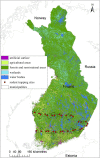The impact of wildlife and environmental factors on hantavirus infection in the host and its translation into human risk
- PMID: 37040809
- PMCID: PMC10089723
- DOI: 10.1098/rspb.2022.2470
The impact of wildlife and environmental factors on hantavirus infection in the host and its translation into human risk
Abstract
Identifying factors that drive infection dynamics in reservoir host populations is essential in understanding human risk from wildlife-originated zoonoses. We studied zoonotic Puumala orthohantavirus (PUUV) in the host, the bank vole (Myodes glareolus), populations in relation to the host population, rodent and predator community and environment-related factors and whether these processes are translated into human infection incidence. We used 5-year rodent trapping and bank vole PUUV serology data collected from 30 sites located in 24 municipalities in Finland. We found that PUUV seroprevalence in the host was negatively associated with the abundance of red foxes, but this process did not translate into human disease incidence, which showed no association with PUUV seroprevalence. The abundance of weasels, the proportion of juvenile bank voles in the host populations and rodent species diversity were negatively associated with the abundance index of PUUV positive bank voles, which, in turn, showed a positive association with human disease incidence. Our results suggest certain predators, a high proportion of young bank vole individuals, and a diverse rodent community, may reduce PUUV risk for humans through their negative impacts on the abundance of infected bank voles.
Keywords: dilution effect; juvenile dilution effect; top–down trophic interactions; zoonotic Puumala orthohantavirus.
Conflict of interest statement
The authors declare no conflict of interest.
Figures


Similar articles
-
Population, environmental, and community effects on local bank vole (Myodes glareolus) Puumala virus infection in an area with low human incidence.Vector Borne Zoonotic Dis. 2008 Apr;8(2):235-44. doi: 10.1089/vbz.2007.0160. Vector Borne Zoonotic Dis. 2008. PMID: 18370592
-
Small mammal community composition impacts bank vole (Clethrionomys glareolus) population dynamics and associated seroprevalence of Puumala orthohantavirus.Integr Zool. 2024 Jan;19(1):52-65. doi: 10.1111/1749-4877.12782. Epub 2023 Oct 29. Integr Zool. 2024. PMID: 37899277
-
Microevolution of bank voles (Myodes glareolus) at neutral and immune-related genes during multiannual dynamic cycles: Consequences for Puumala hantavirus epidemiology.Infect Genet Evol. 2017 Apr;49:318-329. doi: 10.1016/j.meegid.2016.12.007. Epub 2016 Dec 9. Infect Genet Evol. 2017. PMID: 27956196
-
Hantavirus Research in Finland: Highlights and Perspectives.Viruses. 2021 Jul 26;13(8):1452. doi: 10.3390/v13081452. Viruses. 2021. PMID: 34452318 Free PMC article. Review.
-
Hantaviruses and their hosts in Europe: reservoirs here and there, but not everywhere?Vector Borne Zoonotic Dis. 2010 Aug;10(6):549-61. doi: 10.1089/vbz.2009.0138. Vector Borne Zoonotic Dis. 2010. PMID: 20795916 Review.
Cited by
-
High-resolution early warning system for human Puumala hantavirus infection risk in Germany.Sci Rep. 2024 Apr 26;14(1):9602. doi: 10.1038/s41598-024-60144-0. Sci Rep. 2024. PMID: 38671000 Free PMC article.
-
Puumala orthohantavirus: prevalence, biology, disease, animal models and recent advances in therapeutics development and structural biology.Front Immunol. 2025 May 8;16:1575112. doi: 10.3389/fimmu.2025.1575112. eCollection 2025. Front Immunol. 2025. PMID: 40406115 Free PMC article. Review.
-
Epidemiology and Clinical Course of Haemorrhagic Fever with Renal Syndrome in New Endemic Area for Hantavirus Infection in Croatia.Life (Basel). 2023 Aug 18;13(8):1767. doi: 10.3390/life13081767. Life (Basel). 2023. PMID: 37629623 Free PMC article.
-
Hantavirus Research in Finland.Viruses. 2024 Oct 10;16(10):1591. doi: 10.3390/v16101591. Viruses. 2024. PMID: 39459924 Free PMC article.
-
Genes, inflammatory response, tolerance, and resistance to virus infections in migratory birds, bats, and rodents.Front Immunol. 2023 Aug 29;14:1239572. doi: 10.3389/fimmu.2023.1239572. eCollection 2023. Front Immunol. 2023. PMID: 37711609 Free PMC article. Review.
References
-
- Brummer Korvenkontio M, Henttonen H, Vaheri A. 1982. Hemorrhagic fever with renal syndrome in Finland: ecology and virology of Nephropathia epidemica. Scand. J. Infect. Dis. 14, 88-91. - PubMed
Publication types
MeSH terms
Associated data
LinkOut - more resources
Full Text Sources
Medical

